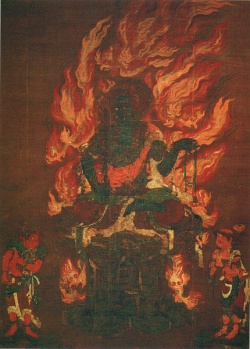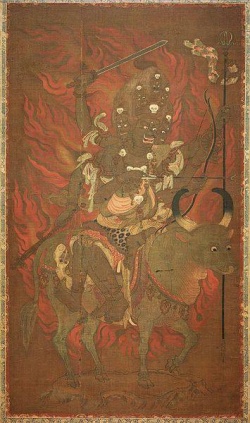Fudō Myōō
Acala (Skr.: Acala, Achala अचल; "immovable" one) is a guardian deity primarily revered in Vajrayana Buddhism in Japan, China and elsewhere.
He is classed among the vīdyārāja and preeminent among the Five Wisdom Kings of the Womb Realm. Accordingly, his figure occupies an important hierarchical position in the pictorial diagramatic Mandala of the Two Realms.
Overview
Descriptions of his physical appearance derive from such scriptural source as the Mahavairocana Tantra (Ja: Dainichikyō (『大日経』?)) and its annotation.
His face is expressive of extreme wrath, wrinkle-browed, left eye squinted or looking askance, lower teeth biting down the upper lip. He has the physique of a corpulent (round-bellied) child. He bears a sword in his right hand, and a lariat or noose (Ja: kensaku (羂索?)) in his left hand. He is engulfed in flame, and seated on a "huge rock base" (Ja: banjakuza (盤石座?)).
Acala is said to be a powerful deity who protects All the Living (sattva, shujō (衆生?)) by burning away all impediments (antar-aya, shōnan (障難?)) and defilements, thus aiding them towards enlightenment.
In Japanese esoteric Buddhism, according to an arcane interpretive concept known as the "three wheel-embodiments(ja)" or san rinjin (三輪身?) Acala and the rest of the five wisdom kings are considered kyōryō tenshin (教令輪身 "embodiments of the wheel of injunction"?), or beings whose actions constitute the teaching of the law (the other embodiments teach by word, or merely by their manifest existence).
Under this conceptualization, the wisdom kings are ranked superior to the Dharmapala (gohō zenshin (護法善神?)), a different class of guardian deities.
Nevertheless, this distinction sometimes fails to be asserted, or the two are openly treated as synonymous by many commentators, even in clearly Japanese religious contexts.
The Sanskrit symbol that represents Acala is hāṃ हां ( conventionally transliterated kān (カーン?)). However, it has been confounded with the similar glyph (हूं hūṃ), prompting some commentators to mistakenly identify the Acala with other deities. (The Sanskrit symbol is called siddham, Ja: bonji (梵字?)), or "seed syllable" (zh: bīja, Ja: shuji (種子?)).
For other Buddhist beings identified with the Acala, see below under #Conflations with other deities.
Some of the other transliterations and variants to his name are Ācalanātha, Āryācalanātha, Ācala-vidyā-rāja. The Hindu form of the deity may also be known as Caṇḍamahāroṣaṇa or Caṇḍaroṣaṇa "the violent-wrathful" one.
History
Originally the Hindu deity Acalanātha (अचलनाथ), whose name in Sanskrit signifies ācala "immovable" + nātha' "protector, Acala was incorporated into esoteric Buddhism (late 7th century, India) as a servant of Buddha.
In Tang Dynasty China, he became Budong (pinyin: Búdòng; Middle Chinese: /pǝw dungx/-(?) 不動, "immovable"), a translated-meaning-name derived from Acala.
In turn, the deity was imported into Japan as Fūdō (不動?) "immovable") by the priest Kūkai (d. 835) who was studying in China as a member of the Kentoshi mission, and founded the Shingon sect of Japanese Buddhism.
As the deity's importance waned in India and China (as did the religion itself), the iconic image remained popular throughout the Middle Ages (and into modern times) in Nepal, Tibet and Japan, where sculptural and pictorial representations of them are most often found. Much of the iconography comes from Japan, where a popular cult especially devoted to him has developed.
In Tibetan Buddhism and art, the buddha Akshobhya, whose name also means "the immovable one", presides over the clan of deities to which Ācala belongs.
Other sources refer to the Acala/Caṇḍaroṣaṇa as an "emanation" of Akshobhya, suggesting further assimilation.
Acala in Japan
The Akafudo, Myō'ōin temple, Koyasan (Mount Koya), Heian period
Fudō-myōō (不動明王?) is the full Japanese name for Acala, or Fudō (o-Fudō-sama etc.) for short. It is the literal translation of the Sanskrit term "immovable".
Acala in Buddhist art since the Heian era has depicted him as angry-faced, holding a vajra sword and a lariat. In later representations, such as those used by the yamabushi monks, he may have one fang pointing up and another pointing down, and a braid on the one side of his head.
The sword he holds may or may not be flaming and sometimes described only generically as a hōken (宝剣 "treasure sword"?) or as kongō-ken (金剛杵 "vajra sword"?), which is descriptive of the fact that the pommel of the sword is in the shape of the talon-like kongō-sho (金剛杵 "vajra"?) of one type or another.
It may also be referred to as sanko-ken (三鈷剣 "three-pronged vajra sword"?).
However in some cases as in the Akafudo painting (show left), the divinity is seen holding the Kurikara-ken(ja), a sword with the dragon coiled around it.
The flaming nimbus or halo behind the statue is known as the "karura flame", after a mythical firebreathing birdlike creature, the garuda.
The two boy servants who is usually depicted in attendance to Acala are named Kongara(ja) (Kiṃkara) and Seitaka (ja)(Ceṭaka) though there are said to be eight such boy servants altoghether, and as many as forty-eight servants overall.
His seat, the banjakuza (盤石座 or "huge rock base"?) "..is considered an appropriate iconographic symbol to demonstrate the steadfastness of" the Fudō. Acala/Fudo Cult
In Japan, Acala became an idol of worship in its own right, and became installed as the gohonzon (本尊) or main deity at temples and outdoor shrines.
A famous example is the Narita Fudo, a Shingon subsect temple at Narita-san.
At Shingon Buddhist temples dedicated to Ācala, priests perform the Fudo-hō (不動法?), or ritual service to enlist the deity's power of purification to benefit the faithful.
This rite routinely involves the use of the ritual burning ceremony or goma (護摩?) (Skr.: Homa) as a purification tool.
Lay persons or monks in yamabushi gear who go into rigorous training outdoors in the mountains also often pray to small Ācala statue or talisman they carry, which serve as his honzon.
This praciticed path of yamabushi's training, known as Shugendō, predates the introduction of Ācala, so at first adored idols such as the Zaō Gongen(ja) who appeared before the sect's founder En no Ozunu or the Vairocana.
But eventually Ācala was added to list of deities most typically enshrined by the yamabushi monks, either portable, or installed in outdoor shrines (hokora).
These statues would be often placed near waterfalls (a common training ground) and deep in the mountains and in caves.
Ācala also tops the list of so-called Thirteen Buddhas (jūsan butsu (十三仏?)).
Thus Shingon sect mourners assign the Fudo the "First Seven Days" (Shonanoka (初七日?)) of service.
The first week is an important observance, but perhaps not as prominently important as the observance of "seven times seven days" (i.e. 49 days) signifying the end of "intermediate state" (bardo).
Literature on Shinto Buddhist ritual will explain that such and such Sanskrit "seed syllable", or mantra or mudra is attendant to each of the "buddhas" for each observance period.
But the scholarly consensus seems to be that the invoking of the "Thirteen Buddhas" had evolved later around the fourteenth century and became widespread by the following century, so this could not have been part of the original teachings by priest Kukai, but rather a later adaptation.
Conflations and Confusions
There is claim that Acala/Fudo is identifiable with one of the "two kings" or Niō (仁王?), or the gate guardian deities in Japan, but that assertion is not backed by many of the available commentary on the deity, and may be a common misconception.
One source which makes this claim explains that the seed syllable हूं hūṃ represents the Acala/Fudo, but Acala's symbol is hāṃ हां as aforementioned, and hūṃ actually belongs to another Wisdom King, Kuṇḍali (Gundari Myōō (軍荼利明王?)).
This latter syllabic symbol, hūṃ, is actually the same as un or "closed mouth" character, frequently associated with the "two kings" or Niō (仁王?), whose resepective opened or closed mouth position are referred to by the phrase A-un (阿吽?).
This probably led to the further assertion that Acala/Fudo was to be identified with the closed-mouthed Nio statue represented by the hūm sound.
If Acala were a Nio gate guardian, then by transference he would belong to the class of beings called Vajrapani (Shūkongōshin (執金剛神?); also known as Kongōrikishi (金剛力士?) in wrestler form), that is to say, or vajra (lightning)-wielding yakshas.
But that would be contradictory to the aforementioned concept of the "three wheel-embodiments", which considers the wisdom-king as a higher class of beings than vajrapani or other dharmapala guardian deities.
However, that is strictly a Japanese interpretation. In commentary on Tibetan art, one encounters many references to the "Acala-Vajrapani".

